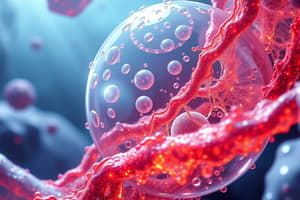Podcast
Questions and Answers
What is the group of medications that includes aspirin known for reducing fever and pain?
What is the group of medications that includes aspirin known for reducing fever and pain?
- Leukotrienes
- Prostaglandin synthetase inhibitors
- Cyclooxygenase inhibitors (correct)
- Lipoxygenase
Which enzyme is responsible for the conversion of arachidonic acid to prostacyclin (PGI2)?
Which enzyme is responsible for the conversion of arachidonic acid to prostacyclin (PGI2)?
- Thromboxane synthetase
- Phospholipase A2
- Prostaglandin synthetase (correct)
- Lipoxygenase
What is the most common adverse reaction associated with indomethacin use?
What is the most common adverse reaction associated with indomethacin use?
- Dizziness
- Seizures
- Gastric bleeding (correct)
- Hallucinations
Which medication is known to act as a vasodilator and have antiaggregating effects?
Which medication is known to act as a vasodilator and have antiaggregating effects?
What is salicylism associated with in patients using high doses of aspirin?
What is salicylism associated with in patients using high doses of aspirin?
Which symptom is NOT commonly associated with chronic toxicity from aspirin use?
Which symptom is NOT commonly associated with chronic toxicity from aspirin use?
Which NSAID has a side effect of prolonging bleeding time?
Which NSAID has a side effect of prolonging bleeding time?
Which NSAID is more potent than indomethacin or naproxen?
Which NSAID is more potent than indomethacin or naproxen?
Which NSAID is known for its side effects including diarrhea and hemolytic anemia?
Which NSAID is known for its side effects including diarrhea and hemolytic anemia?
Which NSAID is effective as an anti-inflammatory, antipyretic, and analgesic agent with a 5-hour half-life?
Which NSAID is effective as an anti-inflammatory, antipyretic, and analgesic agent with a 5-hour half-life?
Which NSAID should not exceed 40 mg/day in pediatric patients with mild pain?
Which NSAID should not exceed 40 mg/day in pediatric patients with mild pain?
Which NSAID has the primary route of excretion for the drug and its metabolites via the kidney?
Which NSAID has the primary route of excretion for the drug and its metabolites via the kidney?
Flashcards are hidden until you start studying
Study Notes
Cell Membrane and Phospholipids
- Phospholipids are the main components of cell membranes.
- Phospholipase A2 breaks down phospholipids, leading to the release of arachidonic acid.
Arachidonic Acid and Metabolism
- Arachidonic acid is converted into leukotrienes by the enzyme lipoxygenase (LOX).
- Arachidonic acid is also converted into prostaglandins by the enzyme cyclooxygenase (COX).
Prostaglandins and Synthases
- Cyclooxygenase (COX) produces cyclic endoperoxides (PGG2, PGH2).
- Prostaglandin synthetase produces prostaglandins, such as prostacyclin (PGI2) and thromboxane A2.
- Thromboxane synthetase produces thromboxane A2.
Prostaglandins and Their Effects
- Thromboxane A2 is a vasoconstrictor and platelet aggregator.
- Prostacyclin (PGI2) is a vasodilator and antiaggregating agent.
- PGE2 is a vasodilator, causing erythema, edema, and pain.
- PGF2α is a uterus contractor, causing pain and fever.
Non-Steroidal Anti-Inflammatory Drugs (NSAIDs)
- NSAIDs inhibit the synthesis of prostaglandins, reducing pain and inflammation.
- Aspirin is the oldest NSAID, known for reducing fever and pain.
- Aspirin's effects include:
- Stabilizing cell membranes to prevent further leakage of substances (edema)
- Increasing peripheral blood flow (vasodilation)
- Prophylactically inhibiting clotting
Aspirin Adverse Effects
- Common adverse effects: nausea, heartburn, dyspepsia, vomiting, gastrointestinal bleeding, and prolonged bleeding time.
- Rare adverse effects: hypersensitivity, rash, laryngeal edema, asthma, salicylism, anaphylactic reactions, and angioedema.
Other NSAIDs
- Indomethacin: common adverse effects include gastric bleeding, ulceration, and CNS effects.
- Ibuprofen, Naproxen, Fenoprofen, Ketoprofen, and Flubiprofen are other NSAIDs.
- Meloxicam: at high doses, nonselective NSAID, inhibiting both COX-1 and COX-2.
- Piroxicam: GI disturbance, used to treat RA, ankylosing spondylitis, and osteoarthritis.
- Mefenamic acid: side effects include diarrhea, inflammation of the bowel, and hemolytic anemia.
- Diclofenac: more potent than indomethacin or naproxen, accumulates in synovial fluid, and primary route of excretion is the kidney.
- Tolmetin: effective anti-inflammatory, antipyretic, and analgesic agent, with a half-life of 5 hours.
- Ketorolac: potent analgesic but has moderate anti-inflammatory effects, available for oral administration, IM use, and topical use.
Studying That Suits You
Use AI to generate personalized quizzes and flashcards to suit your learning preferences.




